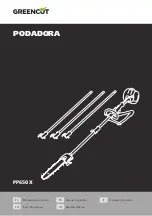
20
• Lay crown molding with its broad back (hidden)
surface down on the turn base with its CEILING
CONTACT EDGE against the guide fence on the
saw.
• The finished piece to be used will always be on the
LEFT side of the blade after the cut has been
made.
In the case of right bevel cut
Table (A)
006363
Table (B)
006364
Example:
In the case of cutting 52/38° type crown molding for
position (1) in Fig. A:
• Tilt and secure bevel angle setting to 33.9° RIGHT.
• Adjust and secure miter angle setting to 31.6°
RIGHT.
• Lay crown molding with its broad back (hidden)
surface down on the turn base with its WALL
CONTACT EDGE against the guide fence on the
saw.
• The finished piece to be used will always be on the
RIGHT side of the blade after the cut has been
made.
7. Cutting aluminum extrusion (Fig. 45 & 46)
When securing aluminum extrusions, use spacer
blocks or pieces of scrap as shown in the figure to
prevent deformation of the aluminum. Use a cutting
lubricant when cutting the aluminum extrusion to
prevent build-up of the aluminum material on the
blade.
WARNING:
•
Never attempt to cut thick or round aluminum
extrusions.
Thick or round aluminum extrusions can
be difficult to secure and may work loose during the
cutting operation which may result in loss of control and
serious personal injury.
8. Wood facing
Use of wood facing helps to assure splinter-free cuts
in workpieces. Attach a wood facing to the guide fence
using the holes in the guide fence.
See the figure concerning the dimensions for a
suggested wood facing.
(Fig. 47)
CAUTION:
• Use straight wood of even thickness as the wood
facing.
WARNING:
•
Use screws to attach the wood facing to the guide
fence. The screws should be installed so that the
screw heads are below the surface of the wood
facing so that they will not interfere with the
positioning of the material being cut.
Misalignment
of the material being cut can case unexpected
movement during the cutting operation which may
result in a loss of control and serious personal injury.
NOTICE:
• When the wood facing is attached, do not turn the turn
base with the handle lowered. The blade and/or the
wood facing will be damaged.
9. Groove cutting (Fig. 48)
A dado type cut can be made by proceeding as
follows:
Adjust the lower limit position of the blade using the
adjusting screw and the stopper arm to limit the cutting
depth of the blade. Refer to “Stopper arm” section
described previously.
After adjusting the lower limit position of the blade, cut
parallel grooves across the width of the workpiece
using a slide (push) cut as shown in the figure. Then
remove the workpiece material between the grooves
with a chisel.
WARNING:
•
Do not attempt to perform this type of cut by using
a wider type blade or dado blade.
Attempting to
make a groove cut with a wider blade or dado blade
could lead to unexpected cutting results and kickback
which may result in serious personal injury.
•
Be sure to return the stopper arm to the original
position when performing other than groove
cutting.
Attempting to make cuts with the stopper arm
in the incorrect position could lead to unexpected
cutting results and kickback which may result in serious
personal injury.
CAUTION:
• Be sure to return the stopper arm to the original
position when performing other than groove cutting.
Carrying tool (Fig. 49)
Make sure that the tool is unplugged. Secure the blade at
0° bevel angle and the turn base at the full right miter
angle position. Secure the slide poles so that the lower
slide pole is locked in the position of the carriage fully
pulled to operator and the upper poles are locked in the
position of the carriage fully pushed forward to the guide
fence (refer to the section titled “Slide lock adjustment”.)
Lower the handle fully and lock it in the lowered position
by pushing in the stopper pin.
Wind the power supply cord using the cord rests.
Molding
position in
Fig. A
Bevel angle
Miter angle
52/38° type
45° type
52/38° type
45° type
For inside
corner
(1)
Right 33.9°
Right 30°
Right 31.6° Right 35.3°
(2)
Left 31.6°
Left 35.3°
For outside
corner
(3)
(4)
Right 31.6° Right 35.3°
Molding
position in
Fig. A
Molding edge against
guide fence
Finished piece
For inside
corner
(1)
Wall contact edge should
be against guide fence.
Finished piece will be on
the Right side of blade.
(2)
Ceiling contact edge
should be against guide
fence.
For outside
corner
(3)
Finished piece will be on
the Left side of blade.
(4)
Wall contact edge should
be against guide fence.
















































